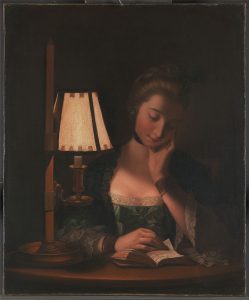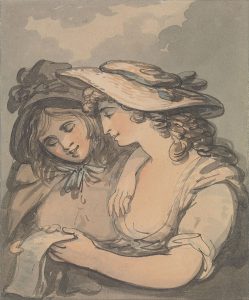
Henry Robert Morland, 1730–1797, British, Woman Reading by a Paper-Bell Shade, 1766, Oil on canvas, Yale Center for British Art, Paul Mellon Collection, B1989.32.
Published between 1760 and 1761 and believed largely to be written by Charlotte Lennox (it was marketed as “by the Author of The Female Quixote”), the Lady’s Museum sought simultaneously to educate and entertain its readership. It did so through a variety of media, including letters to and from the editor, poetry, biography, history, natural history, natural philosophy, translation, educational treatise, geography—even perhaps the first serialized novel. Initially launched in 2021 and continued through 2023 with the support of the Canadian Society of Eighteenth Century Studies’s (CSECS) D. W. Smith Research Fellowship and the American Society for Eighteenth-Century Studies’s (ASECS) Women’s Caucus Editing and Translation Fellowship, the Lady’s Museum Project is an open-access, in-progress critical edition of (and learning community around) Lennox’s visually stunning and fascinating early magazine, featuring both audiobook and interactive, textual editions (for a one-page project overview, click here.)
The Lady’s Museum Project presents Lennox’s two-volume magazine—the first updated version since its initial eighteenth-century edition printed by John Newbery—in two forms: an abridged teaching edition intended for an audience of undergraduate-student and public users, and a scholarly edition aimed at eighteenth-century specialists. Previously, the periodical was housed behind the paywall of Eighteenth-Century Collections Online (ECCO); however, as of fall 2023, volumes 1 and 2 of the Beinecke Rare Book and Manuscript Library’s holdings are now freely available to the public on its website and linked to from LadysMuseum.com (thanks to Rebecca Maguire, MSW and the Public Services and Reproductions teams at Yale University for these high-quality scans). Scholars and students can now compare the original edition—including its illustrations, maps, and figures—side by side with the text on LadysMuseum.com, which used as its base text the Oxford Text Creation Partnership (TCP) transcriptions.
The teaching and critical editions are purposefully included side-by-side within the same .com, community-centered site (rather than as a .edu, which would have associated the site with one institution) in order to practice feminist editing principles that decenter traditional binaries of scholar/student, editor/writer. The co-editors have designed this editorial space and apparatus for “coworkers” from various institutions, nations, and educational and professional backgrounds to likewise work side-by-side to co-create a version accessible to both audiences for this historic feminist recovery work.
The website was initially conceived when (then-graduate students) Karenza Sutton-Bennett (Ph.D., University of Ottawa) and Kelly Plante (Ph.D., Wayne State University) teamed up to design a digital home for the course reader and curriculum developed by Professor Susan Carlile (University of California, Long Beach) and (now Dr.) Sutton-Bennett and published on Aphra Behn Online: Interactive Journal for Women in the Arts (1640–1840) (Carlile and Sutton-Bennett). We are grateful to Professor Carlile for her encouragement, support, and positive example in her feminist recovery work. The site has expanded beyond that initial conception; it has morphed into an in-progress learning community, a communication hub that prioritizes relationships, mentorship, and care. This site, in other words, values DH process over “product.”
Feminist DH Theory and Method
Past, present, and future collaborators in this transnational and transdisciplinary effort to recover the work of Lennox, the trailblazing editor, and of periodical studies and the history of women in the press more generally, are affectionately referred to as “Triflers,” borrowing the term from the Lady’s Museum’s “The Trifler” section, as outlined in the Eighteenth-Century Fiction article, “A Numerous and Powerful Generation of Triflers”: The Social Edition as Counterpublic in Charlotte Lennox’s the Lady’s Museum (1760–61) and the Lady’s Museum Project (2021–).” The co-editors adopted this idea of “trifling” as a DH method to center “care and maintenance over innovation” and to draw a distinction between this “small data” project and “Big Dick Data Projects” (Barnett; D’Ignazio and Klein). Catherine D’Ignazio and Lauren F. Klein characterize “Big Dick Data Projects” as “masculinist, totalizing fantasies of world domination as enacted through data capture and analysis. Big Dick Data projects ignore context, fetishize size, and inflate their technical and scientific capabilities” (D’Ignazio and Klein).
Committed to practicing intersectional feminism wherever and whenever possible, the co-editors have presented on three ways of practicing intersectionality in DH projects (by spotlighting group-, process-, and system-generated inequities for multiply marginalized persons), adapted from intersectional sociology and educational policy research, outlining the methods by which we continuously strive to do so (Robert and Yu; Choo and Ferree; Twenty-First Century Digital Editing & Publishing). Group-centered intersectionality—representation of multiply marginalized persons—and process- and system-centered intersectionality—spotlighting processes and systemic oppression of multiply marginalized groups—can be discussed and practiced in classes that assign the imperialism curriculum option, including the Lady’s Geography and Princess Padmani series, which depict women of present-day Ambon Island, Sri Lanka, and India (Carlile and Sutton-Bennett). (The project would be enriched by more critical introductions to orient generalist and nonspecialist readers on these subjects; contact the editors as outlined at the bottom of this article and here, if you and/or your students would be interested in writing and publishing on these and other subjects).
The Abridged Teaching Edition (2021–2023)
The project has, as of fall 2023, completed phases 1 and 2 of its three-phase developmental cycle. The teaching edition is now 100% annotated by undergraduate students, for undergraduate students, with definitions that reference and link externally to Johnson’s Online Dictionary and critical introductions to contextualize readings (like “Charlotte Lennox, Eco-Feminist?” by Spring/Summer 2023 intern Bailey Meyerhoff). It is fully ready to enhance and assist your teaching of the historic literary magazine. Classrooms in institutions across the U.S. and Canada, including the University of Ottawa, Wayne State, Brandeis, and Texas Woman’s universities and the Community College of Rhode Island, have developed the annotations and critical introductions and beta tested the text, assignments, and activities. All individuals are credited with gratitude on the About this Project page and attributed prominently with bylines at the beginnings of the annotated texts and critical introductions.
The Full-Text Critical Edition (2024–2026)
Entering into phase 3, the project carries forth the collaborative, collegial spirit that built the teaching apparatus into the critical edition. The team seeks to connect with graduate and postgraduate, early- and mid-career and senior scholars who are interested in participating at various levels in building this very first critical edition of the Lady’s Museum, using feminist DH methods that destabilize the traditional editorial process in ways only possible in an online edition. In 2024, we will be presenting our plans for the critical edition and soliciting interested collaborators from a variety of institutions and generations of scholars, at the British Society for Eighteenth-Century Studies (BSECS) and in an ASECS-sponsored roundtable at that organization’s annual meeting with collaborators Professor Ashley Bender (Texas Woman’s University), Professor Carlile, Jennifer Factor (Ph.D. candidate, Brandeis University), Professor Karen Griscom (Community College of Rhode Island), and Bailey Meyerhoff (graduate student, Wayne State University). Also in 2024, the book chapter “‘The present therefore seems improbable, the future most uncertain’: Transcending Academia through Charlotte Lennox’s Lady’s Museum (1760–61),” will be published in Twenty-First Century Digital Editing & Publishing, edited by Dr. James O’Sullivan (Scottish Universities Press) in/with support of the C21 Editions initiative funded by the Arts & Humanities Research Council (AHRC) and the Irish Research Council (IRC) as part of the UK-Ireland Collaboration in Digital Humanities.
Read/Work with Us
If you are interested in joining this “numerous and powerful generation of triflers” from the eighteenth- and twenty-first centuries, please do not hesitate to contact us at the.ladys.museum at gmail.com. Collaborative projects could include, for instance, teaching with this edition, inviting the co-editors for a talk at your institution, learning more about the Lady’s Museum and this project’s theory and praxis, annotating articles or writing introductory, contextualizing essays, or providing students with the opportunity to annotate and write introductions. Instructors can use our lesson plan as a guide.
Social Reading Options
The website enables social reading by integrating hypothes.is and embedding PDFs for upload to course learning management systems and Perusall. Users can also print the PDFs of the teaching edition and the Lady’s Museum Project bookmark.
The Lady’s LibriVox: Open-Access Audiobook of the Lady’s Museum
In the spirit of destabilizing teacher/student and editor/contributor binaries, the Lady’s Museum Project also declines to privilege the printed (or digitized) text over either image or spoken word. Enter the Lady’s LibriVox subproject in which Factor spearheaded the recording process for the first open-access audiobook of the magazine, starting with her (excellent) narration of Lennox’s satirical “Trifler” essays. Summer 2023 saw the completion of volume 1, now available to listen to in full (and assign to classes) on archive.org and LibriVox.org. Volume 1 was project-managed by (now Dr.) Plante, and volume 2 is being managed by Dr. Sutton-Bennett. You can volunteer to lend your voice to the feminist and periodical recovery project by signing up to read a section at the Lady’s Museum, vol. 2 LibriVox page.
Write and Publish on Ladysmuseum.com
The project will be enriched by more critical introductions and essays, especially intersectional-feminist readings of the Lady’s Museum and essays that interrogate imperialism in the History of Princess Padmani, Original Inhabitants of Great Britain, and Lady’s Geography article series. It would also benefit from more general introductions aimed at student readers and a generalist audience (such as “Critical Reception of the Lady’s Museum,” “Genres in the Lady’s Museum,” “Lennox and Translation,” “Lennox and Samuel Johnson,” etc.). For a list of critical introduction topic ideas, go to https://ladysmuseum.com/about-the-ladys-museum/. To pitch or submit a new article, or one you or a student has written for a class, email the editors at the.ladys.museum at gmail.com.
Internships
We have mentored undergraduate and graduate student interns interested in publishing and editing careers from Brandeis University, Texas Woman’s University, the University of Massachusetts, the University of Ottawa, and Wayne State University. Brandeis and Wayne State universities funded the graduate student internships. There have also been less formal mentorship relationships, which we are always happy to develop. Publishing and editing internship and mentorship relationships are always tailored to students’ interests. Students are coached through the process of writing critical introductions, annotating articles, and/or audiobook narration and publishing. We are interested in adding the Lady’s Museum Project to other university and college English departments’ lists of internship opportunities, so that more students can have the experience of writing and thinking about literature professionally.
Works Cited
Barnett, Fiona. “The Brave Side of Digital Humanities,” differences: A Journal of Feminist Cultural Studies 25.1 (2014): 64–78. https://doi.org/10.1215/10407391-2420003
Carlile, Susan. “‘Before I am Quite Forgot’: Women’s Critical Literary Biography and the Future.” Aphra Behn Online (ABO): Interactive Journal of Women in the Arts, 1640–1840 13.1 (2023). https://digitalcommons.usf.edu/cgi/viewcontent.cgi?article=1320&context=abo
Carlile, Susan and Karenza Sutton-Bennett. Aphra Behn Online (ABO): Interactive Journal of Women in the Arts, 1640–1840 12.1 (2022). https://digitalcommons.usf.edu/abo/vol12/iss1/7/
Choo, Hae Yeon and Myra Marx Ferree. “Practicing Intersectionality in Sociological Research: A Critical Analysis of Inclusions, Interactions, and Institutions in the Study of Inequalities,” Sociological Theory 28.2 (2010). https://doi.org/10.1111/j.1467-9558.2010.01370.x.
D’Ignazio, Catherine and Lauren F. Klein. Data Feminism. Massachusetts Institute of Technology Press, 2020. http://mitpress.mit.edu/9780262358538/data-feminism.
Plante, Kelly J. “The Lady’s Museum Project: A Digital Critical Edition in Phase 1 of Its Development, Now Available for Teachers and Students to Learn Collaboratively through Charlotte Lennox’s Lady’s Museum (1761-62).” Aphra Behn Online (ABO): Interactive Journal of Women in the Arts, 1640–1840 12.1 (2022). https://digitalcommons.usf.edu/abo/vol12/iss1/9/.
Plante, Kelly J. and Karenza Sutton-Bennett. “‘A Numerous and Powerful Generation of Triflers’: The Social Edition as Counterpublic in Charlotte Lennox’s the Lady’s Museum (1760–61) and the Lady’s Museum Project (2021–).” Eighteenth-Century Fiction 35.2 (2023). https://doi.org/10.3138/ecf.35.2.287.
—. “‘The present therefore seems improbable, the future most uncertain’: Transcending Academia through Charlotte Lennox’s Lady’s Museum (1760–61).” Twenty-First Century Digital Editing & Publishing. Scottish Universities Press, 2024.
Robert, Sara A. and Min Yu. “Intersectionality in Transnational Education Policy Research.” Review of Research in Education 42.1 (2018): 93– 121. https://doi.org/10.3102/0091732X1875930.
Sutton-Bennett, Karenza. “Intellect versus Politeness: Charlotte Lennox and Women’s Minds.” Eighteenth-Century Fiction 35.3 (2023): 375–96. https://doi.org/10.3138/ecf.35.3.375.
